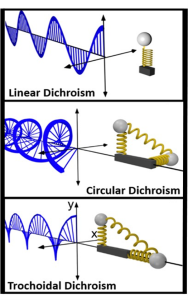
The spatial arrangement of electric and magnetic fields composing light is described by polarization. Optical Dichroism is the differential extinction by a material when interacting with differently polarized light. Linear and circular dichroism (LD and CD) spectroscopy uses polarized light to gather information about analytes, including anisotropy, alignment, and handedness because anisotropic and chiral plasmonic nanoparticles (NPs) interact uniquely with different polarizations. Plasmonic NPs offer enhanced CD compared to molecules due to their strong interaction to circularly polarized light. Chemical templating of NPs, coulombic interactions, and enhancing local chirality improve the CD signal, making plasmonic NPs attractive for sensing molecular CD. CD’s low sensitivity due to its reliance on far-field radiation can be improved using highly confined, structured light like evanescent waves, interference fields, and focused Gaussian beams.
The Link Research Group has introduced a novel form of dichroism, trochoidal dichroism, utilizing polarization states in confined electromagnetic waves. These surface-confined evanescent waves have different polarization properties, including longitudinal electromagnetic oscillations that are absent in free-space light. These waves demonstrate planar, rotational motion aligned with the light propagation direction, occurring in clockwise (CW) and anticlockwise (ACW) polarization states. Enhancing our understanding of nanoscale polarized light-matter interactions is crucial for developing effective polarization-discriminating components in nanophotonic circuits and advancing spectroscopic techniques utilizing confined light fields.
The Link Research Group is interested in deciphering the structure-function relationships that give rise to different forms of optical dichroism for single nanostructures composed of individual or assembled nanoparticles, utilizing our expertise in correlated optical and electron microscopy as well as electromagnetic modeling.
Selected publications:
- L. A. McCarthy, O. Verma, G. N. Naidu, L. Bursi, A. Alabastri, P. Nordlander, and S. Link, Chiral Plasmonic Pinwheels Exhibit Orientation-Independent Linear Differential Scattering under Asymmetric Illumination, Chem. Biomed. Imaging, 1, 1, 30-39 (2023)
- L. A. McCarthy, K. W. Smith, X. Lan, S. A. Hosseini Jebeli, L. Bursi, A. Alabastri, W.-S. Chang, P. Nordlander, and S. Link, Polarized evanescent waves reveal trochoidal dichroism, PNAS, 117 (28) 16143 (2020)
- K. W. Smith, H Zhao, H. Zhang, A. Sánchez-Iglesias, M. Grzelczak, Y. Wang, W.-S. Chang, P. Nordlander, L. Liz-Marzán, and S. Link, Chiral and Achiral Nanodumbbell Dimers: The Effect of Geometry on Plasmonic Properties, ACS Nano, 10 (6), 6180 (2016)
- W.-S. Chang, B. Willingham, L. S. Slaughter, S. Dominguez-Medina, P. Swanglap, S. Link, Radiative and Nonradiative Properties of Single Plasmonic Nanoparticles and Their Assemblies. Acc. Chem. Res. 45, 1936 (2012).